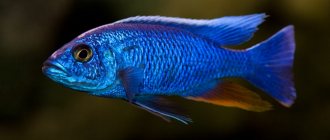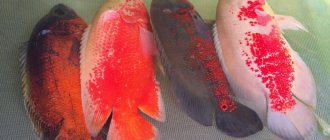author: fisher 02/11/2017 0 Comments
Family: Cyprinidae
other fish
The cardinal (Tanichthys albonubes, Lin, 1932) is a compact four-centimeter fish of the carp family (Cyprinidae) - one of the most common aquarium fish. The first specimens of cardinals were discovered and caught by Chinese boy scout leader Tang Kang Fei in the White Cloud Mountains, a few kilometers away north of the city of Guangzhou. This is where the species name of the fish comes from - albonubes (alba nubes, which means white clouds in Latin). And the name of the genus was given by the director of the Canton Ichthyological Station, Lin Shuen, who was the first to describe the species, in honor of its discoverer.
Cardinal - veil form
Already in 1932, the first specimens of cardinals were brought to the USA, and soon spread to other countries, including Germany. After appearing in European aquariums, cardinals immediately won an army of fans, thanks to their peacefulness, compactness, amazing decorativeness, and ease of maintenance. In addition, they can be bred even in relatively cool water. At first, cardinals were often compared to neons, calling them “poor man's neons,” since blue neons were still rare and too expensive at that time, and cardinals were relatively cheap.
Even now, almost a century later, cardinals , along with zebrafish, guppies and swordtails, are the first to appear in the aquariums of most beginning hobbyists.
Description
Despite its unremarkable size, the cardinal is a bright and colorful fish with an elongated and slender body, which is slightly flattened in front and on the sides. On top of the muzzle is a small mouth, which is positioned this way because in nature it collects insects from the upper layers of water. The fish does not have antennae, the dorsal fin is located in line with the anal fin.
The color is bronzed-brown, with a bright stripe running through the axis of the body. There is a bright red spot on the tail, part of the tail is transparent. The abdomen is lighter, unlike the rest of the body, the fins are slightly veil-like, also colored crimson-red. There are artificially bred colors, even albinos.
When the fry reach a length of 4-5 mm, a shiny silver-blue stripe appears on their body, which disappears when they reach a length of 2-3 cm, that is, when they reach sexual maturity. Males are slimmer and more elongated than females, the differences between them are weakly expressed. The character of the aquarium fish is active and mobile.
Cardinal (fish) is a fish of the Cyprinidae family, class Ray-finned. It got its name because of the desire for easy money from traders who hoped that it would be better sold for industrial purposes. The Latin, classical species name is more euphonious: “alba nubes”, which literally translates as “white clouds”. These fish were first discovered in China.
In Guangdong, China in 1930, a pioneer leader named Tang Meng Yo made the first records of cardinals. The description stated that this fish survives well in water with a low temperature, and, as it later turned out, aquarium conditions are also not a bad place for it. Later it was sold under different names, and “cardinal” was not the only one. Chinese zebrafish, false neon, magnificent minnow - such names were often found on the market.
The fast rivers of South China are the natural habitat of cardinals. Keeping and breeding them is only possible in aquarium conditions, since in the wild they are almost exterminated. Since the 80s, there has been no notification of their population locations. In China, this species was temporarily considered extinct. Miraculously, it turned out that a small school of fish was found in some Chinese and Vietnamese provinces. All fish sold today are bred in captivity.
Title history
The history of cardinals dates back to the first century AD. e. - to the seven ancient deacons chosen by the apostles and appointed to care for poor Christians (Acts -6). Under the Roman bishop, the tradition of electing seven privileged archdeacons was maintained for a long time, who soon concentrated in their hands enormous financial, administrative and even spiritual power, since they reported directly to the pope. Moreover, the popes themselves often depended on their closest and powerful subordinates - the papal archdeacons - who began to be respectfully called cardinals. The papal archdeacons did not lose the title of cardinal even when they were promoted, ordained presbyters and, further, bishops. Over time, all cardinals began to be ordained bishops, but at the same time they receive a double (parallel) spiritual rank. That is, those Catholic bishops who bear the title of cardinal, no matter in what part of the world they head their dioceses, are necessarily assigned to one of the parish churches of the city of Rome as a simple priest or even a deacon.
In the east of the Roman Empire under Emperor Theodosius I the Great the word Cardinalis
occurs as the name of an official.
From the 5th to the 11th centuries, this was the name given to clergy who occupied permanent positions at certain city parish churches, who were firmly connected to their places, “like a door is connected to the hook on which it hangs.” While in other places the title "cardinal" lost its meaning and disappeared from use, in Rome it became increasingly important. Rome was divided into seven districts (“a city on seven hills”), each of which had its own main church - Titulus
- and its abbot was called
incardinatus
,
cardinalis
. These churches were parish churches in the proper sense - only the sacred church sacraments were taught in them. Cardinal-priests and cardinal-deacons of Rome were present in the council of the pope and took a significant part in his election, when the choice depended on the clergy and people, but were also considered (as can be seen from the acts) below any bishop. There were no cardinal bishops then, but the bishops of the Roman metropolis, of course, took part in both the council and the selection of the pope.
Editorial: Rotala Bangladesh
Cardinal's coat of arms
It was only from the 11th century that these suburban bishops: Ostia (now Ostia and Velletri), Porto, Santa Rufina (later united with Porto), Albano, Sabina, Tusculum and Palestrina (Preneste) were called cardinals
Of great importance in the history of the development of the cardinalate is the decree of Pope Nicholas II issued at the Lateran Council (1059), by virtue of which the College of Cardinals received the right to choose the pope. This decree remains in force to this day.
Under Innocent IV, the cardinals received a status above all bishops and a red cap, symbolically meaning that until the last drop of blood, without fear of death, they would act “pro exaltatione sanctae fidei, pace et quiete populi christiani, augmento et statu Sanctae Romanae Ecclesiae” (“ for the sake of the exaltation of the holy faith, peace and tranquility in Christian nations, the growth and strength of the Holy Roman Church").
- Boniface VIII gave them the princely mantle;
- Paul II - the right to have a white horse with a red blanket and golden reins;
- Pius V in 1567 prohibited those who had not received this rank from the pope from being called cardinals;
- And under Urban VIII (1630), the cardinals received the title of lat. "Eminentissimus", "Eminentia", "His Eminence", worn by the ecclesiastical electors.
Cardinal in nature
The historical homeland of these cyprinids is considered to be fast-flowing mountain streams located in southeast China.
From there the cardinal was brought to Canada (1935), then came to the USA, and after that to Europe, or more precisely to Germany (1938).
It should be noted that from 1980 to the present, cardinals are considered an extinct species in China. This is due to human influence on wildlife: mass catching of fish for aquarium keeping, pollution and drainage of water bodies. A small number of fish have survived in the provinces of Gaung Dong (China) and Quang Ninh (Vietnam), but it is negligible. The Chinese government is taking measures to preserve and restore the population.
All fish that are sold and that we see in pet stores are bred in captivity.
Main characteristics
“Cardinal” is an early grape variety with cylindrical clusters, a chic Muscat taste and a honey aftertaste that will not leave you indifferent. It is also worth noting such varieties as “Baikonur”, “Gourmet Early” and “Monarch”.
Ripening period
In terms of ripening time, “cardinal” refers to early grape varieties. From the moment the plant begins to develop in spring until the harvest ripens, about 115-120 days pass. The collection of ripe grapes begins in mid-August. In the hot climate of southern Russia, the harvest has time to ripen already on the 105th day.
Bush
The bushes of this variety are vigorous and can reach a length of 3 meters. The vine is powerful and strong and has a bright brown color. With good agricultural technology, bush growth increases. The five-lobed leaves are medium-dissected, their surface is smooth and without pubescence. A bronze border can be traced at the ends of the denticles of young leaves.
Bushes need regular pruning. Depending on the growing region, vines are molded in one of the following ways:
- High standard. This type of bush formation is distinguished by its decorative effect and high productivity. Suitable for southern regions, where there is no need to organize a winter shelter and remove the vine from its support in the fall.
- Fan or two-arm cordon. These methods are suitable for growing “cardinal” in cooler latitudes, where the vine needs to be covered for the winter.
“Cardinal” is prone to bush thickening. To ensure more abundant harvests, it is necessary to regularly monitor and remove all excess shoots and shoots. The average yield from 1 bush is 20-25 kg.
Bunches and berries
Large clusters are located on long green stalks and have the shape of an elongated cylinder, tapered towards the end. They are approximately 25 cm long. They are loose or very loose in structure, the berries do not fit tightly together.
The average weight of a bunch is about 500 g, but there are individual specimens weighing up to 900 g.
The berries are large - 2.2 cm in diameter, 3 cm in length. The average weight of one fruit is 10-12 grams. The berries are round in shape and can be slightly beveled on top and have a small groove. The color ranges from dark pink to violet-red, with a smoky finish. The berries ripen unevenly throughout the cluster.
The thick skin allows ripe fruits to be stored for quite a long time. The pulp is juicy, fleshy, greenish-white in color, contains up to 4 large seeds.
Sugar content – 17-18%. Acidity – 6-8 g/l.
Reference! The size of the berries depends on the care. The more comfortable conditions are created for the grapes, the larger the cluster and berries on it.
Taste
The crispy pulp is harmonious and refreshing in taste, has a light nutmeg aroma and a honey aftertaste.
Despite the relatively dense skin, it breaks easily and is practically not felt when eating grapes fresh.
Cardinal - maintenance and care
Cardinal fish are considered peaceful and non-aggressive aquarium inhabitants, which are recommended to be kept in schools of 6-8. They get along well with thorns, red neons, rhodostomus and zebrafish. Generally, cardinals stay in the top layer. You should not have any difficulties keeping the cardinal aquarium fish. Prepare a small aquarium based on the proportion of 30 liters of water per flock of up to 7 pieces. Make the water level in it 25 centimeters.
Aquarium soil can be used in the form of river sand, which must be treated before placing it in the aquarium. You can also use small pebbles as a substrate. It is also recommended to plant aquarium plants, but not too densely. As a rule, Elodea, Ludwigia, Hornwort or Vallisneria are planted in the aquarium. The parameters of aquarium water in an aquarium with cardinal fish should be the following: hardness: 4-20, pH: 6.5-7.5, water temperature: 18-21 degrees. The aquarium requires water filtration and aeration, as well as weekly changes of up to 20%. Cardinals also love bright light, which is especially important during the winter.
There is cardinal live and dry food. Perfectly eats cyclops, bloodworms, dry daphnia. In natural conditions there are small insects almost all the time.
Feeding
Cardinals will eat all types of food, such as live, frozen, flakes, and pellets.
In nature, they mainly feed on insects that fall to the surface of the water. And in the aquarium they eat well small live food - bloodworms, tubifex, brine shrimp and various flakes.
Do not forget that they have a very small mouth, which is directed upward and it is difficult for them to eat large food from the bottom.
Cardinal fish: compatibility
The optimal conditions for a flock of good-natured small cardinals are a separate aquarium. They will be most comfortable there. It is very interesting to watch their calm games, and the cardinals will clearly be more active in breeding and behaving in a calm environment. Calm and cheerful fish, cardinals are too peaceful.
They may be offended by representatives of aggressive breeds. Neighborhood with predators such as astronotus, piranhas, barbs, angelfish, and goldfish is dangerous. It is worth considering the lack of agility of the cardinals. Even completely peaceful inhabitants of the aquarium, whose size and strength are greater than those of these fish, will be serious competitors for them when sharing food and territory.
A lack of food or a comfortable place will affect the general well-being, ability to reproduce, and appearance of cardinals. If you still want to observe a variety of inhabitants in your glass pond, you can take a closer look at guppies, fire tetras, zebrafish, rhodostomus, ternets, neons, honey gouramis, corydoras, glass perches or shrimp.
Appearance
In terms of body shape, cardinal shrimps are not much different from their relatives: they also have two sections (cephalothorax and abdomen), five pairs of walking limbs, small abdominal legs, a horizontal tail blade, etc. The key feature is color. The body has a red color, which, however, varies from light to dark burgundy. It is worth noting that the intensity of the color in no way indicates the age, gender or condition of the animal. Small white dots are scattered throughout the body, contrasting well with the body color. Sometimes you can see a bluish outline around them.
Cardinal shrimp. Appearance
All limbs of the cardinal shrimp are red, with the exception of the front ones, which are painted white. It is very funny to watch the process of feeding a shrimp, while its forelimbs are in constant motion.
Differences between males and females
Cardinals do not have clear gender differences, but the owner can still quickly determine which of his pets is a “boy” and which is a “girl.” Males are smaller in size than females, but their color is more intense, attracting attention. Females have a full, rounded abdomen.
Individuals reach sexual maturity at 6-13 months. The fact that the male has reached this period can be understood by his behavior: the fish begins to “perform” in front of other male competitors, revealing its fins and demonstrating its bright colors. Such “pirouettes” attract the attention of “ladies”.
Reviews
Breeders speak positively about this species. Fish are attracted by their beauty and small size. These are unpretentious pets with easy care.
Reproduction and breeding
Cardinals are unpretentious and easy to keep and breed. They spawn and are able to spawn all year round. There are two options for breeding these fish:
- When keeping a flock of cardinals in one tank, you can let everything take its course and expect offspring. These fish are not prone to cannibalism, they don’t even touch the eggs, so after a couple of months the aquarium will be full of growing individuals.
- The second option is to install a small (20-40 liter) spawning tank. You should put a couple of males into it, choosing the brightest colored ones, and 4-5 females. It is necessary to place vegetation in the container on the leaves of which cardinals lay eggs.
It is worth taking care of suitable water parameters - softness pH 6.5-7.5 and temperature from 18 to 22°C. There is no need to cover the bottom with soil in the spawning tank, but a little filtration and a weak current will be useful. It doesn’t matter whether the fish spawn in a community aquarium or separately, they must eat well - plenty of high-quality live food. Suitable meat is shrimp, daphnia, and tubifex. If there are no live rations, you can give frozen ones.
When the female lays eggs on the leaves of the plants, the parents can be returned to the common tank. After one and a half to two days, the fry will be born, they are fed with small starter feeds - rotifers, live dust, crushed egg yolks. Even the tiny cardinal is quite tenacious - it is very easy to feed the babies, especially since they grow quite quickly.
The cardinal is a small, nimble fish that does not require complex care. And if a novice aquarist gets such nice pets, then he does not have to face disappointments and failures. These inhabitants of the underwater world are distinguished by their liveliness, mobility and good disposition - an ideal combination for a mini-aquarium community.
Death
By the autumn of 1642, Richelieu's health had deteriorated sharply. Neither healing waters nor bloodletting helped. The man regularly lost consciousness. Doctors diagnosed purulent pleurisy. He tried his best to continue working, but his strength was leaving him. On December 2, the dying Richelieu was visited by Louis XIII himself. In a conversation with the king, the cardinal announced a successor - he became Cardinal Mazarin. He was also visited by envoys from Anne of Austria and Gaston of Orleans.
Cardinal Richelieu on his deathbed
His niece, the Duchess de Aiguillon, did not leave his side in recent days. He admitted that he loved her more than anyone in the world, but he didn’t want to die in her arms. Therefore, he asked the girl to leave the room. Her place was taken by Father Leon, who confirmed the death of the cardinal. Richelieu died on December 5, 1642 in Paris; he was buried in a church on the territory of the Sorbonne.
On December 5, 1793, people burst into the tomb, destroyed Richelieu’s tomb in a matter of minutes, and tore the embalmed body to pieces. The boys on the street were playing with the mummified head of the cardinal, someone tore off a finger with a ring, and someone stole the death mask. In the end, these are the three things that remain from the great reformer. By order of Napoleon III, on December 15, 1866, the remains were solemnly reburied.
How long do they live in an aquarium?
Like most small aquarium fish, the life expectancy of a cardinal in artificial conditions does not exceed one and a half to two years.
The ease of care and maintenance of cardinals is one of the main reasons for the popularity of this type of aquarium fish. Their unpretentiousness to the dimensions of the aquarium, water parameters and type of food allows them to be kept not only at home, but also in the office. These schooling and moderately shy fish are very interesting to watch, restoring mental strength and balance.
Diseases
Cardinals are susceptible to several types of diseases:
- Infection. Enters through other fish, dirty water, contaminated soil.
- Parasites (external and internal). They appear due to improper care, poor quality food, and infected fish.
- Fungus.
- Problems in the gastrointestinal tract. Occurs due to improper nutrition.
Most diseases can be prevented by keeping the aquarium clean and using quality fish food.
Interesting Facts
- In Asia, cardinals are sometimes kept as pond fish. They are not only beautiful, but also help in the fight against mosquitoes.
- These cyprinids are able to withstand temperature changes from 14 to 30 degrees.
- The name cardinal is a commercial move. Traders gave it to these fish so that the goods could be sold better. This name was often found in German books on aquarium husbandry of that time, from where it came into Russian speech and took root.
- In China and England, the fish are called white cloud mountain minnow, or Guangdong minnow. They are named so because of their habitat. Cardinals can be found in the fast and cool water streams of Mount Baiyunshan, which is also known as White Cloud Mountain.
As we can see, caring for cardinals is really not difficult. They are loyal to the volume of the dwelling, and to the water parameters, and to the food. The only thing that is important is to keep the water clean. And so these fish will delight the owner not only at home, but even in a mini-aquarium in the office on the desktop.
ENDLER'S GUPPY CONTENTS REPRODUCTION PHOTO COMPATIBILITY DESCRIPTION VIDEO.
Neighborhood
Cardinals are peaceful fish, do not conflict with anyone, so they get along well with almost any type of aquarium inhabitants, excluding aggressive, predatory or overly large breeds.
A good option would be:
zebrafish
characins
poeciliaceae
herbivorous bottom catfish
Cardinals can become quarrelsome only when they distribute territory during the breeding season. Considering that at this time they are placed in a spawning area, the problem is eliminated. The rest of the time, cardinals are active, but not annoying, do not start fights among themselves and do not attempt to kill the young of other fish.
Fish feel best in a school of 8 - 12 individuals. A smaller number can also survive, including in a small aquarium, but it is still better to stock the fish in sufficient numbers.
Price
Cardinals are widely available for sale. The cost of aquarium fish depends on the size, breeding form and pricing policy of the seller.
| Size 1-3 cm | Average cost, in rubles |
| Cardinal | 45-55 |
| Golden cardinal | 50-60 |
| Veiled cardinal | 100 |
| Albino | 75 |
Selected morphs are less commonly found on sale and are often available only to order.
Comparison with analogues
Many breeders are interested in this grape variety because of its high taste characteristics and yield. Therefore, “cardinal” has become the basis for many successful hybrid forms.
The most popular among gardeners are three varieties, which were obtained by crossing “cardinal” and other grape varieties: “Cardinal Lux” (also known as “Cardinal Sustainable” or “AZOS”), “Arcadia” and “Rochefort”.
| Sign | Variety | ||
| Cardinal Lux | Arcadia | Rochefort | |
| Ripening period | 120-125 days | 115-125 days | 105-110 days |
| Frost resistance | up to -23ºС | up to -21ºС | up to -23ºС |
| Yield per bush | up to 50 kg | 30-50 kg | 6-10 kg |
| Bunches | from 400 g to 1 kg | 500-700 g (up to 2 kg) | 600-1200 gr |
| Taste | harmonious nutmeg | unobtrusive with light nutmeg | sweet with light nutmeg |
| Color | from red-blue to dark blue | white | dark purple |
| Disease resistance | high | average | average |
| Shelf life | up to 3 months | up to 2 months | up to 3 months |
Sexual Dimorphism
Determining gender is not so easy. Generally, the male is brighter in color with a more slender body than the female. The dorsal and anal fins of the male are wide and fan-shaped, while those of the female are triangular and wedge-shaped.
Veiled cardinal (Tanichthys albonubes) male and female, pair, difference.
During the spawning period, the female's abdomen becomes fuller and rounder.











